
VRpatients: Designing Your Own VR Training for Healthcare
- August 30, 2023
Listen and Subscribe on Your Favorite Platform:
Episode Summary
Experience the immersive journey into the world of healthcare simulation with VRpatients – a pioneering force that’s shaping the future of medical education. In this episode, we sit down with Devin and Will from VRpatients, a company redefining clinical medical education for nurses and EMS with its groundbreaking platform. Devin shares his journey from being a customer of VRPatients to becoming an integral part of the team, highlighting how his previous work experiences shaped this transition.
Discover the essence of VRpatients – a platform that brings programmable mannequins to life in virtual reality. VRpatients enables clinical educators to effortlessly design, deploy, and evaluate a variety of patient scenarios. As Devin shares his own experiences with VR, we explore the excitement surrounding new innovative solutions and the meticulous preparation required to set VR up for success.
Learn about the “hands on” approach that VRpatients takes with schools and all the intricacies and challenges to making VR work seamlessly. We uncover captivating insights from their pioneering work in VR and the challenges they’ve encountered while scaling their transformative platform.
Devin’s deeply personal connection to VRpatients adds a poignant touch to our conversation. We also delve into intriguing discussions, such as the Apple Vision Pro talk, hinting at the future of VRpatients and the evolving landscape of medical education.
Key Moments
- How Devin started out/past work experience into how he got to VRpatients (00:54)
- Started as customer of VRpatients into working there (04:10)
- What is VRpatients (05:27)
- Will’s experience in VR (07:28)
- Typical prep before getting hands on experience/what’s exciting about immersive solutions (10:40)
- How do you address making VR work (VRpatients’ process) (14:01)
- Scale/scope of current customer base (18:01)
- A-ha moment (20:06)
- Process of selling to leadership/his role in that (22:58)
- Use case, marketplace to be released in future (24:16)
- Challenges trying to scale (26:26)
- Personal “why” for Devin and ArborXR (29:13)
- Apple Vision Pro talk + wrap (33:52)

About the Guest
Devin holds an undergraduate degree in Health Sciences from Northern Arizona University and has been a certified emergency hospital paramedic for 8 years. He also serves as adjunct faculty at the Public Safety and Emergency Services Institute in Southern Arizona and is an experienced clinical genetic research assistant for the University of Arizona’s NIH Precision Medicine Initiative.
In addition to his healthcare expertise, Devin is a credentialed VR educator through Georgian College, serves as the Head of Marketing for VRpatients, and is the owner of the not-for-profit Immersive Medical YouTube Channel and podcast. Prior to his career in healthcare and education, Devin spent 10 years as an accredited Producer and television host in Los Angeles. His unique combination of technical skills in media production, public speaking abilities and passion for healthcare allows him to effectively convey the value of immersive technologies in nursing simulation.
About VRpatients
The VRpatients platform is an asynchronous and remotely accessible clinical simulation tool that reaches beyond the classroom deploying real life scenarios to 10 or 10,000 students simultaneously anywhere in the world. Our unique partnership with ArborXR empowers educators by simplifying IT device management, while VRpatients handles the software toolkit for crafting dynamic simulations. With VRpatients, instructors can engage students outside the classroom with an interactive, dynamic training environment focused on clinical decision making. Students can practice formative virtual simulations from anywhere, perform summative evaluations at the sim center, debrief in-person with trackable analytics, and translate their virtual experiences into actual clinical skills. VRpatients, real life training without real life consequences. Learn more on the VRpatients website.
Links and Resources
- Learn more about VRpatients
- Read how a nursing college reimagined education with VRpatients
- Check out the Immersive Medical podcast on YouTube, Apple, and Spotify
- Connect with Devin on LinkedIn
- Connect with Brad on LinkedIn
- Connect with Will on LinkedIn
Learn more about getting started with XR in our ultimate guide to managing VR training for work.
Episode Transcript
Brad Scoggin: Hey there, welcome to “XR Industry Leaders” with ArborXR. My name is Brad Scoggin, and I am the CEO and one of three co-founders of ArborXR. And we’ve had the opportunity of working with thousands of companies since 2016, and we’ve learned a ton about what it takes for XR to be successful in your organization.
Will Stackable: And I’m Will Stackable, co-founder and CMO. This podcast is all about interviewing the leaders who are on the ground making XR happen today. True pioneers in the space from Amazon, Walmart, and UPS to Koch, Pfizer, and beyond to uncover the pitfalls, lessons learned, and secrets that you can use to help grow XR in your organization.
Brad Scoggin: Well, today, we get to sit down with Devin Marble. Devin is the head of marketing for VRpatients. We’re excited to have you on the show today, Devin.
Devin Marble: Thank you. I’m excited.
Brad Scoggin: Well, as you know, we always love to get a little bit of backstory on our guests. So we know that you have had a fairly extensive career in entertainment, production, even maybe some TV hosting. So I’d love to hear maybe some of your favorite projects and how you made the jump from doing that into immersive technology.
Devin Marble: Oh, thank you. And thank you guys for having me here. I’m really honored to be on this podcast. I’m a fan; I listen. So I’m geeking out a little bit.
Brad Scoggin: Amazing.
Devin Marble: I started out in, gosh, I spent 10 years in Hollywood. And just to answer your question really quickly, I think my favorite show to work on as I was the story producer for all the episodes of Project Runway, season eight with Tim Gunn and Heidi Klum. That was a good one. You know, my past, I… I started out I wanted to be a veterinarian when I was a kid, but I was told that I just didn’t get good enough grades and couldn’t do it. And I just didn’t chase that down, didn’t apply myself to it. Then, I ended up getting into drama class. I asked my buddies, like, what should I do? I can’t be a vet. And they’re like, come into drama. And I’m so shy by nature. That drama was really hard for me. Anyways, I took to it. I loved it and decided. That’s what I’m gonna be when I grow up. I’m gonna do something in entertainment. That pushed me out there for 10 years, and I learned that I wasn’t helping anybody but myself. And I also learned that I chose a way harder career than becoming a vet or any kind of medical person, right? Because look, it’s hard to become a doctor or a vet, for sure, but once you get your degree, you get to be that thing. And it doesn’t matter how many degrees you have; you don’t get to be famous. You don’t get… You also have to get struck by lightning. And so when I had that aha moment, I got reconnected with my high school sweetheart. We got married. I moved us back to our hometown to get our feet under us. And I headed headfirst into medical. And that’s when I became a paramedic. I became a clinical genetic researcher at the University of Arizona. I was teaching at the community college. I built their VR studio for them. I was pre-med. It was a four; it was a five-year journey to be pre-med. And in 2020, I canceled my med school application to lean into digital because of this thing called VR that was happening that I was good at. And all of the media, content creation, and technicality of using video, I had learned, I was practiced at it. The medical stuff was tough. So, I was able to kind of combine these two worlds. And then, when the pandemic hit, it was like a rocket ship. And I’m very fortunate to be working on the team at VRpatients. kind of building something for public health and building something for the future of healthcare that includes immersive solutions at scale. That’s kind of how I got there. I hope that was a straight line.
Brad Scoggin:Yeah, that’s a great story. I love that. I love the, you know, we were talking in the pre-interview. If you would have told me you were shy ever, I don’t think anyone would have guessed that. But I love how you kind of brought it all together. And obviously, for all of us, I mean, COVID was such an accelerant for XR.
Brad Scoggin: But so tell us, you know, you, so you started out at Pima College as a customer of VRpatients, and you made the transition to work with VRpatients. Maybe tell us about that journey a little bit.
Devin Marble: You know, VRpatients are the type of team that wants to work with people who want to get it done. And what ended up happening was I was providing solutions to them because I loved the product, and I was able to implement it at the college. And I just started working with them as often as I could. And they slowly started to let me join the team. So, I have been working with VRpatients for over a year and a half. before I joined the team as a full-time employee. And, you know, and now I’m gonna move out to headquarters, even though we’re digital and remote, there’s something about being able to shake hands with your team and get to the chalkboard or whiteboard and really get stuff done. And, you know, we’re moving quickly, so I’m very excited to push that forward with them.
Will Stackable: So I want to, before we go any further, I want to hear you explain to us what is VRpatients. Brad and I actually got a chance to download a module. Set up in the clinic as a, you know, I don’t know what you’d call it, I guess, to do the training ourselves, but give us a little bit, I want to share my feedback, some of my takeaways from the experience, maybe if that’s okay, but I want to hear, how would you describe VRpatients?
Devin Marble: VRpatients is an immersive clinical competency training platform. So we help either the professional or the initial paramedic, nurse, or EMT. It can go up to critical care and even help train residents and physicians in the decision-making process. So we don’t dabble in pick up this three-dimensional model that looks like an IV and try to get it up to the skin and put it in with Oculus controllers or zero haptics and
Devin Marble: You know, hand tracking. We don’t mess with that. So when you choose to do a skills intervention like IV, it appears on the avatar, and it is 100% up to you to figure out why did you put that IV there. What kind of IV was it? What are you putting in it? How much? When? What’s wrong with the patient? Have you had a dialogue with them? Are you being a? And that is what we test on in an objective grading rubric, which means there’s no subjectivity to it. So, Will Stackable , for example, if you’re in the system and you’re clicking away, and you’re looking at the patient avatar, you’re trying your treatments, and you make a mistake, and I’m your proctor, and I’m like, you know what, you did a pretty good job. I know you meant to do this when you did that, and the patient’s okay, so we’re gonna give you the points and move you forward. That doesn’t happen in VRpatients. And that’s intentional because we want our clinicians, our instructors, our educators, to be able to deploy at scale and let their students asynchronously practice in a safe, comfortable environment and iterate and trust that the simulation is gonna keep them true. They have to click through it. They have to get through it and make the decisions. And then they get the feedback. So when they come in for actual skills time debriefing, I mean, you can do VRpatients live on campus, absolutely, and have a whole classroom. But if you do deploy at scale and the students come in, think about the questions that those students are gonna ask. Today, in clinical simulation, you go to class every day, and when there’s a sim day, you prep for it and then you run sims. But what if those students had been practicing in a non-destructive environment all semester, all year? They’ve done 300 patients. What kind of questions is that student gonna ask when they arrive at SimDay with the Proctor? I’m hoping they’re gonna be way more thoughtful, way less about the actual Sim and more about the disease.
Will Stackable: Beautiful, I love it. I have to share my experience as a totally ignorant, non-medical; my wife is a nurse; that’s the closest I get. When she starts telling me stories about work, I, you know, if it involves blood, I just have to leave, I can’t even hear it. So that’s my background. But, so for me, I get into the headset, we go into an experience, and there’s basically a patient sitting in a bed, or laying in a bed in front of me, who looks like she’s in pretty bad shape, pretty beat up. And you said you prepared it specially, there’s a bit of a shock factor. She was missing an arm or a hand.
Devin Marble: I didn’t know you were squeamish with blood.
Will Stackable: Oh yeah, it was great. So, it was interesting because on the right, you have basically a panel of options, and it’s pretty overwhelming as a non-medical student. You have no idea. So you have an assessment panel, you have a dialogue panel where you can have conversations. Um, there are all different types of instruments. I realized at one point that I had a monitor that could show everything from an EKG, I think, to a heart rate monitor, blood pressure, um, blood oxygen. And you go through basically a diagnostic. I mean, you’re having to make decisions about whether I should run labs here? Should I put a cuff on to check blood pressure? Should we do an IV? If so, what’s the size of the IV, and what’s the type? Should I put it in a saline solution or not? I think one of my takeaways was, man, It just gave me appreciation for the complexity of the job of any doctor or nurse because you have so many, you have a patient who seems like they’re in trouble, they’re breathing heavily, complaining of chest pain. And as a doctor, you have so many potential tools and roads you could go down. And so I thought it was such an interesting, just as a lay person, it was fascinating and a bit overwhelming. And I don’t think I killed her, but I was trying all the different things. You know, I think I stuck an IV in at one point and… And then I did one of, it was a nose cannula with oxygen, and she said, as soon as I put it on, she said, the pressure makes me feel like my eyes are gonna blow out.
Will Stackable: And so I turned down the oxygen pressure. So anyway, it was a great experience. I’d love for, yeah, so this is the first I’ve heard that you guys are really focusing on this specific use case, which is helping med students train. ahead of, so when you describe a little bit the use case where, as a student, are you typically, what’s a typical preparation you’d have before you go in and get hands-on experience? Are you usually reading in a textbook, and that’s the alternative?
Devin Marble: Yes, yes, it is. You would be surprised at how little patient contact you get at the beginning of your education, like the first half of your education, especially for doctors, oh my goodness. But that’s why physicians have, you know, two or three years of residency. But that’s really trial by fire. You come out of years of theory and memorizing and just thousands of pages. I mean. into real people, it is nerve-wracking. Nurses, I mean, if you’re gonna get a bachelor’s of science in nursing, it’s a four-year program. Simulation is not really a part of that first year. It could be a part of the second year, but it’s really really entry-level stuff. They don’t really engage with the patient care side of things until they start to get there at the book. And part of that reason is to not overwhelm the students; right, you have plenty to learn. So we’ll get to patients when we get to patients. And there is a roadmap that they currently have in nursing curriculums. What’s so exciting about immersive solutions is that they really allow you to sprinkle in clinical education, and it’s just non-destructive. You can assign a grade to it, but you don’t have to. And you can let the students fail. You can, for the first time ever, be in… you know, year one cardiology chapter, learning about conduction and like plus and minus and, oh, so it’s an electrical conjunction. It goes from here to there. Wow, that’s why the heart squeezes. And then that night, put on your VR headset and go, so this is a heart attack patient?
Brad Scoggin: Mm-hmm.
Devin Marble: I have no idea what to do here. And it talks to you, and you go, holy cow, this is what I’m in for. This is what I’m gonna do. I’m excited.
Brad Scoggin: Mm-hmm.
Devin Marble: And that is, I think that is just super exciting. There is an educational gap there, which is for the educator. It’s part of the challenges of VRpatients and any number of us out there creating these immersive solutions. We really have to educate the customer on how to sprinkle this throughout your curriculum because it’s so new.
Will Stackable: Yeah.
Devin Marble: I mean, you can’t sprinkle Lairdol mannequins throughout a student’s curriculum because it requires two instructors to set it up and get everything ready. You have to fill it with fluid. It’s got like an iPad connected to it. You have to be there. It costs $100,000, so the student doesn’t get to play with it by themselves. You know, and so to be able to have an immersive solution, that’s a 10th, that cost and infinitely scalable, uh, is real power for the educator. And I love what you said just now. It warmed my heart that you said as a layperson, you had an appreciation for the medical provider. I never even thought about that. And I think that is an incredible, I don’t know, use case.
Brad Scoggin: Yeah, I thought it was, yeah, it was very cool; I mean, you’re in the waiting room, and then you’re in the, whatever, the operating room. It felt the patients room,
Brad Scoggin: Very real.
Brad Scoggin: Yeah, the patient’s room, and they’re already, there’s so many; I was doing it; several of my family members are in the medical field. So I was doing it around them, we’re visiting some family, and they overhear me saying it, and they’re like, how do you know that it was a fun experience? But I’m curious; I think one thing we’ve seen over the years as we’ve worked in different, with different groups doing VR education, what you just said is a challenge, right? It’s like, there’s no question, and we can talk about this more a little bit. I don’t think there’s any question before I tried VRpatients, but even, and you know, I’m not a medical person, okay, the benefit, it seems to be very, very clear, but it does, the challenge of how do you fit this in? I mean, how do you guys address that with the different groups? I’m sure they look at it, and this is amazing, now, how do we make it work in a way, like, what’s your process there?
Devin Marble: So our process is, I like to think of VRpatients as built by nurses and EMS for nurses and EMS because we have a ton of SME, subject matter experts, on our team. So we’ve got nurses building, constructing these template cases because
Brad Scoggin: Mm-hmm.
Devin Marble: The system comes with a library of patients ready to go that are based on all the standards and accrediting guidelines and vetted by an actual nurse or by an actual paramedic. And so we really are shoulder to shoulder with the front line. as we create this solution to make sure that it’s useful for them.
Brad Scoggin: Yeah.
Devin Marble: But how do we bridge that gap in education? Really, what we have to do is hold their hand and show them. For example, we create custom curriculums for the onboarding customer at the point of demo. So we’re demoing with a customer, we’re showing them the solution, and then they go, and here, we downloaded your nursing curriculum. And we have, we’re going to show you, look at, this is how you could use VRpatients in nursing 3, 4, 5, you know, whatever the, the class code is. And, for nursing 1, 0, this is how you could do it. And we take their course descriptions and provide them back this handheld. Like it’s going to be okay. We’re going to help you win and succeed before you even become a customer. So you can have an understanding of how this industry can have a positive impact. You, it’s just a much better hammer to build a much bigger house.
Brad Scoggin: Yeah, you know what the handholding, I got to sit on that for a second because I think, goodness, we were just on earlier with one of our partners doing some sales enablement, and it’s a bigger organization, and I heard our sales team talking to them just about meeting the handholding, right? And it feels like with where XR is at, with where VR is at, those of us who are in this early stage, we have to, even on our team sometimes, we’re ready to scale, let’s think about how we, but you know what, in so many ways, we’re still in the hand holding phase, and for this thing to really take off, and I think what’s frustrating is like, again, you get in this content, anybody who gets in your content, this is amazing. Right, you put on a VR headset. This is amazing, and there’s, but there’s still this gap. Between, I mean, you talked about the gap in curriculum versus, you know, implementing a new tool, but there’s this gap in usability almost. And I think for anybody listening to this who’s thinking about how to scale XR in their organization, and again, we all love to say scale, scale. So it feels like once
Brad Scoggin: We can say scale, we’ve done something. But the reality is the way we scale is by doing the hard things early, you know, sleeping on couches, hand holding.
Devin Marble: Right.
Brad Scoggin: So I think that’s really, that’s just the key. It’s great to hear you say that. And it’s even a good reminder for us, I think, well, you know, just for all of us in the space. Like the hand holding early on is what creates the foundation for this thing to grow. And for people to really get to experience the impact of it.
Devin Marble: Well, then, part of VRpatients is community-built. So there’s a vested interest in us handholding with the customer because we don’t just want them to onboard and then see you later.
Brad Scoggin: Mm-hmm.
Devin Marble: We want them to have pride in what they’re creating and creating their own patient library. And so that means we want you to be good at our platform, not just have access to it. And that requires us to be there for you. And we are.
Will Stackable: You talked about community-driven. I think that’s really important. Could you just share a little bit about the scale and scope of your current customer user base? Just so we can all understand, what are we talking about? Yeah.
Devin Marble: Oh sure.
Devin Marble: So, VRpatients are used by thousands of clients. Those clients are organizations, individuals, clinical educators, simulation specialists, and professional paramedics; some of them are even resident physicians, and really, there are quite a few of them. But without VRpatients’ assistance, other than helping them fix a few things, they are building their own patients. And that community-built patient library is approaching 2000 right now. Just think about that for a second. If we have 350, for example, registered educators, instructors, and simulation technologists, and between them, they’re building thousands of patients, and they’re all accredited based on their local standards and guidelines. They’re the subject matter experts. They’re professionals. Brad, your wife, Well, your wife, both of you guys are wiser than medical. I’m not gonna presume to know more than them about the patients that they treat. And if they’re gonna teach someone else on their wisdom, on their experience, well, they should be able to use a tool that can bend to the way that they wanna teach, to their curriculum. And that’s really exciting to me, that kind of scale, and they all own their library; it’s all theirs.
Will Stackable: And that’s something, you know, I didn’t get to get into, I didn’t see the, the backend of being able to build out these experiences, but as I was going through it, I was imagining all the flexibility here to really design all different challenges in a variety of scenarios. If you look at the website, um, you have all these different, you can put them in a clinic setting, but you can also put them in their house or in, or for a paramedic, you show up and they’re on a city street. I think that flexibility is really unique. Um, You talked about how you have thousands of devices, thousands of these experiences that have been created. Zoom in to just one moment. Have there been any aha moments where you’ve worked with an educator, and they’ve kind of lit up, and you’ve seen, oh, they’re getting the power of this thing?
Devin Marble: Yes, we have a couple of stories. Um, all right, I’ll tell you, I’ll tell you one story. So we’re out at a conference, and I think this was about a year ago, and one of our customers came to the conference, and they had been a customer for, I think, almost two years, and they came to our booth raving about the product, and we’re asking them, tell us what it’s like. What do you like? You know, what don’t you like? Let’s really pick, you know, let’s poke at this a little bit. And everything this gentleman was describing was WebGL. You know, he likes how the mouse turns into a stethoscope and how real the lung sounds sound and how he can do the pupils with his mouse. And we’re like, do you use it in virtual reality? And he said, no, that’s new technology, I don’t know. And it’s that same hurdle, that hardware divide, that we are all dealing with in this industry, which I’m really excited for Apple, right? Because they’re helping break that down now. with their new device. But anyways, so he’s there at the booth, and we’re like, well, we have a VR headset right here. Would you like to try it?
Devin Marble: And so he tries it out. His mind exploded right there. He leaves our booth and goes back to his hotel. He orders a meta headset, has it overnighted to his hotel, brings it to our booth the next day, and we help him set it up. And he, of course, went back to his institution, and now they’re on VR. And… the aha moment for him. We have a photo of him on his hands and knees at our booth, and he’s underneath the patient who’s sitting on the cot and he’s looking under the feet to try to assess the skin of the blue toes from like deoxygenation and stuff because he couldn’t see that angle on the WebGL, and he was just so fascinated that wait a minute, so I can walk around this patient, I can look at any angle, there’s something there? We’re like, yes, there’s something there. We call our platform WhizzyWig, which is what you see is what you get. And some of the features we had to go extreme with, so for example, if your patient appears to have some yellow skin, that’s jaundice. That’s a liver problem. That is something you need to note. It’s not just the game. That’s a poor artwork in the game, right? What you see is what you get.
Brad Scoggin: I love that. Tell us about, so a lot of times we talk about, you know, proof of concept and moving towards scale. So that was a great story. Are you’re typically selling to an institution or to individuals? And, like, what is that process like selling into, and maybe even, I guess, there’s probably some evangelism to leadership within that org, and what role do you all play in that? How does that kind of play out?
Devin Marble: Yeah, so we do sell at the enterprise level, and for individuals, it’s free. They just go on like this; for example, if they have a MediQuest headset, they could just go to the MetaStore, type in VRpatients, and download it, and they can play with three patients. So today, we are enterprise level, which means it’s a university, a community college, an ambulance company, a firehouse, a hospital, but because we can scale, it’s also a state like we recently onboarded the entire state of Maine. The product is gonna be used to train all of their EMS, right? And that is, that’s really exciting. And so, but these are enterprise-level, right? Customers in the future, we’re really looking forward to, Ooh, I think I might, I think I might drop something here on the pod. I think it might give you a hot take.
Brad Scoggin: Do it!
Devin Marble: We’re really excited about this idea of a marketplace that’s community build. So I want you to imagine. Think of this use case for a moment. COVID hits Seattle really hard. The disease, disease is coming, and all those physicians and educators and nurse educators out there are like, holy cow, this is novel. This is a problem. And one of them builds that patient and then deploys it to everybody else. And the rest of the country gets to practice on a new disease coming. How do I treat this? What do I treat this with? Why? What’s this happening? And. That is what we’re excited about. And that’s just like a use case, but the idea is that the subject matter expert in Arkansas can build something and offer it in the marketplace. We then provide them a token so they can download a different one. And someone else goes, I want that Arkansas’s case. It’s really good.
Brad Scoggin: Mm-hmm.
Devin Marble: I like it; I’m gonna download it. And so we’re really excited about that future.
Brad Scoggin: Well, no, that’s I mean, to me, even, you know, the COVID example is very powerful, but just the basic you said you got 2000 different I mean, there’s endless scenarios, right? And so the fact that those scenarios would be built by experts in the community that then others could pull from, and having been in there, I can tell, it can become pretty complex if need be, right? So being able to, you can imagine that a teacher saying, okay, this week we’re gonna work on this case, I’m gonna build this in advance, you work on it. I mean, that’s, it’s really, and there is something about, one thing we talk about, and I haven’t talked about it in a while, but. We see it across the board, right? So we have a lot of education customers. We have a lot of enterprise customers, and you know, we look at it as just learning, but the learning revolution is what I call it, that VR is enabling. I mean, it’s that people are learning faster. People are retaining more information. You need less, you know, we talked, we worked with, or we interviewed UPS, that you don’t need a truck or a trainer in that scenario.
Devin Marble: I listened to that episode, yeah.
Brad Scoggin: Yeah. So maybe in this scenario, you don’t need a cadaver or whatever or a trainer to practice. can practice a hundred times or a thousand times. Maybe talk a little bit about, I mean, the state of Maine is really cool, and thinking about what’s fun too in all these cases, it’s like you’re just getting started right, that’s one state, that’s the EMS in that state, you’ve got, I’m sure you’ve got your interaction with different universities and how much potential that is to grow, but when you think about deploying to a state or to an entire university or a university system, what are some of the challenges, unique challenges maybe for you guys when you do try to go to scale?
Will Stackable: With the idea that you’re handholding, that you described this early role in VR— how do you do the handholding, but also the scale side of things?
Brad Scoggin: Yeah, the balance.
Devin Marble: So one of the challenges that, it’s hardware really is the biggest challenge. People just can’t get over this idea that it’s a completely new device, and it doesn’t really fall into the category of a computer or an iPad and it’s this totally new device. And it’s like, so does it sit plugged in, and how do I clean it, and how many do I need, and which one do I get? And so what we have decided to do is we’re going to pick one that we have validated. We’ve selected the MetaQuest 2 headset because of its affordability, its scalability, and its use case. It has its own challenges, and many of those challenges, ArborXR helps us overcome, which we really appreciate. Facebook is the challenge. And so what we do is we’re offering a, here’s another hot take.
Brad Scoggin: Yeah, I love it.
Devin Marble: We’re offering a new solution that’s coming in the future. This idea is that it’s this one-stop shop that you can order from VRpatients. And if you want us to just, if you wanna make an order and three to four weeks later, a box is gonna arrive at your door with all the headsets, they work, they’re connected to your Wi-Fi automatically, everything’s loaded onto it, your logins are in, you just basically turn it on. We will do that for you. And so that is a new offering coming in
Brad Scoggin: I love the future of that as well.
Will Stackable: Beautiful.
Devin Marble: And this idea of handholding, right? In order for us to get there with the customer, we’re gonna take a little step ahead of them, create something and then hand it back and say, we know this is a challenge. That’s why we’ve created this for you. Because we don’t make, like, we’re not upselling on the Meta headset. It’s just the MSRP.
Brad Scoggin: Mm-hmm.
Devin Marble: You’re gonna buy it anyway.
Brad Scoggin: Right.
Devin Marble: So, if you want our recommendation, we’re happy to provide it. And if you want us to just pull the trigger for you on that recommendation because you’re gonna make that purchase anyway, we’re happy to do that for you.
Brad Scoggin: Well, you’re so confident in the value, right? I think all of us who have been in XR long enough are like, you just have to try it. Like once you try it, it’s gonna expand in your whole org. And so I think many of us are willing to take that extra hand-holding step in the beginning because we know the value. I mean, it’s just, it’s super clear.
Devin Marble: Yep, absolutely.
Will Stackable: I wanna, as we wrap, I wanna ask you a question about your, kind of your personal why. I know VRpatients’ tagline is, I think, something like real-life training without real-life consequences, which reminds me of Dr. Balenson from Stanford.
Brad Scoggin: That should just be VR’s tagline, by the way. It’s amazing.
Will Stackable: I mean, yeah, Dr. Balenson from Stanford says that VR is great for anything that’s difficult, dangerous, or expensive to simulate in real life. I almost like your tagline better than that: real-life training without real-life consequences. And you can start there, but I’d like to hear what’s your personal why for getting into VR? You strike me as a true believer, and I’m always curious. Like, what drives you? When you wake up, what gets you excited to go to work?
Devin Marble: Man, that is a deep question. You know, it stems from my wife’s getting into medicine. I learned early that I didn’t want to run into a burning building because it was on fire. That’s not me.
Brad Scoggin: Sure.
Devin Marble: But I fell in love with the medicine. You know, I started out as an EMT in an ambulance. We delivered our first patient to the emergency department, and he was sick. And I asked my partner, what’s gonna happen to that guy? He’s like, I don’t know, that’s not our job. And I was like, wait a minute, but is he gonna be okay? He goes, I don’t know. He said, but I do know that the paramedics in that emergency department know more than the paramedics on our box, which is a little bit of an exaggeration. I don’t wanna knock on ambulance medics; they’re amazing. My brother-in-law’s an ambulance medic. But that really made me wanna get into that emergency department because I wanted to help heal that person. And when I got connected with VR, man, it was an aha moment for me. I was standing in front of someone that looked real in an environment that felt real; it sounded real. And there were clues, right? I was able to look around and go, hey, your clothes are disheveled and dirty. You don’t have any shoes, and you’re next to a trash can. Are you sick? Are you feeling okay? And how valuable is that for the nurse who… Typically, he doesn’t get to see that. You know, in nursing education, we call that social determinants of health. All the things in your social life that determine your health, your financial status, who the people you hang out with, what you eat, where you live, like all the things, the demographics of your area, they impact your health. So, how does a nurse include those in their healthcare and their training at the bedside? Well, they have to take a history; they have to ask questions, but can they visualize? Those answers and those responses. So I think my why is this idea of I do miss patient care and treating people. But I feel like I can impact way more people positively through immersive scalable solutions. And if people like that, who feel that strongly about it, who are tied to it, who were once in healthcare, who are in healthcare, are trying to create a healthcare solution. That, to me, sounds like a recipe for a real problem solved. by the community for the community. So maybe that’s what drives me.
Brad Scoggin: I love that. That’s what’s so good. And I mean, you know, for us, and I think for any of us who are in XR, you know, ARBR, there’s so much promise and potential in the technology; we all see it, especially those who are in it. But it’s been a slog. I mean, we’ve been in this since 2016, which feels like a lifetime, I mean just a lifetime. And so I think it’s so important that we do have, you know, a conviction about the technology, and we do have a strong why. And for us, you know, very similar to yours, just kind of our side of the equation and saying, wow, we get to work with dozens or hundreds of VRpatients in different industries. We get to work with Axon, who has created police de-escalation training, helping prepare police officers for dangerous situations. Saving lives. There are so many examples out there. And yeah, just that really resonates. I mean, I think for us, removing the friction to see this technology go to scale quickly and easily. And we think a lot about that initial. hand holding apart right that initially you have one shot at a first impression and leadership is they’re naturally resistant to new technology or change no matter how great it is right and so whatever we can do to come in and make that initial experience so I love that let’s just we’ll end with a light wrap here uh the apple headset was just announced Apple Vision Pro,
Will Stackable: Making waves.
Brad Scoggin: It wouldn’t be right if we didn’t talk about it. So give us your thoughts. How does it impact VR?
Brad Scoggin: How does it impact healthcare?
Devin Marble: I think it’s gonna be super impactful. I cannot wait for the face pewter to arrive.
Brad Scoggin: The face filter.
Will Stackable: Oh, I coined it here.
Devin Marble: I’m super jazzed about it. Not because I think that clinical educators are gonna be using it. No, no, no. So It’s because today, you do not see XR products in the wild. I mean, the HoloLens is eight years old, right? You’ve never seen one.
Brad Scoggin: That’s a great point.
Devin Marble: Right, you don’t see him at a coffee shop. Oculus, 11 years ago with the Rift, and then bought by Meta, and then billions poured into it to make the most affordable solution. Never seen one in the wild. Right,
Will Stackable: Yeah.
Devin Marble: It’s like some rich kid’s living room. He’s just playing games. But you don’t see him at a coffee shop. But what Apple’s done is they flipped it, right? They took a VR headset and made it AR first, always on camera. Do you know how huge that is? For two reasons: one, we know that lens technology is coming in the next three or four years, and people are going be prepared to see their applications in their living space on something more that looks like glasses. But two, why in the world would I take my Meta Quest headset to a coffee shop to work on anything, right? If I can’t see, someone’s gonna take my bag.
Devin Marble: Like, would you go into a coffee shop and blindfold yourself and drink some coffee? No, not in a million years. And so the Vision Pro, you’re gonna start to see it in the wild. Not only is it a status symbol, but the computing power is crazy. And the way that integrates with your laptop for productivity alone, and because you can see people and see things, and this just provides a level of safety, it provides a level of comfort, and… you know, because it’s Apple, it also has a status symbol. When you start to see those in the wild, that is gonna make it easier for your customers, Albrecht’s customers, to pitch up the chain to leadership that this is something that we should invest in because today they pitched something that they have never held, have never seen up the chain. And they go, so you’re telling me that we need this, but I’ve never seen one, and why do we need this? Make the use case. Which is why I always recommend it to people. who are trying to sell up the chain at their institution or organization, you never sell the Zoom demo to the leadership. Get the Zoom demo done, and then you get that software provider to send you a headset, or if you have one, get a free demo, download it on the headset, and you get leadership immersed at their first impression.
Will Stackable: Create a device.
Devin Marble: And that’s the key.
Brad Scoggin: Yeah, that is great advice. I love that take, and yeah, I mean getting someone in the headset. We’ve said that for six or seven years, right? That’s the only way to sell VR is to get into VR.
Will Stackable: Even Apple has a market; I mean, they say VR has a marketing problem and that it’s not cool when you’re, but Apple’s probably come the closest to solving that. And I love your point, which I haven’t actually heard; that’s a great take that you are gonna start seeing them at coffee shops. And it’s a combination of, it’s an Apple headset, people wanna, you know, plus it has productivity software that actually works with your MacBook. But the dial is huge, and I haven’t heard people
Devin Marble: Yeah.
Will Stackable: Talk about that enough because people make fun of it, but. You’re so right; if I’m in a coffee shop, I wanna be able to see around me, I wanna see my peripheral, I wanna be able to see my hands grab the coffee cup. The Quest has the, you can double tap and go through the pass-through, but you feel like you’re in X-ray vision, like Superman or something, it’s not a comfortable experience. So that’s really interesting; I can’t wait till we start seeing them at coffee shops. I’m gonna, the first one, I’m gonna take a photo, and it’s gonna be a moment. It’s a milestone, you know, it’s a huge milestone.
Devin Marble: I’m seriously considering replacing my desktop setup.
Will Stackable: Really?
Devin Marble: Right now, I’ve got three monitors in front of me, and they’re big. They take up and occupy all this desktop space.
Brad Scoggin: Mm-hmm.
Devin Marble: And I have the Immersive Medical Pod to edit by Friday, because we’re gonna launch it, right? So I’m also traveling for a conference this week. So you know what I have to do, is I have to get rough cut done on this desktop computer, and then put that onto my laptop so I can polish during the week, because I’m not gonna have access to this. hard drive to all of that stuff. But if I had my MacBook with my Faceputer, then I could be on the airplane with three monitors and everything computing right there. And so when I’m at work at home, I can have different things on my desk. I can have more space for other things. And so that’s just, that’s something that’s very interesting.
Brad Scoggin: It is.
Devin Marble: I want to speak to something that you said, Brad, about, you know, you’ve been in this for six, 2016, and it just feels like forever. And it just feels like so much handholding. I want to encourage y’all to stick this out because, and I know that you guys are going to, but the WHO has predicted a shortfall of 15 million healthcare workers by 2030. That’s seven years away, which means that starting today, if we don’t start training with clinical competency. 2 million more nurses per year for the next seven years, that’s just to come out even, to meet the need.
Brad Scoggin: Wow.
Devin Marble: And institutions are being charged for clinical time now. If you want to go into the hospital, you have to charge your students to get in there now.
Brad Scoggin: Oh wow.
Devin Marble: And so states there are 32 states that signed into law being able to replace one-third of your clinical time with an immersive solution.
Will Stackable: Really?
Devin Marble: So it’s coming.
Will Stackable: Wow.
Devin Marble: And… These people are gonna need to know how to handle more than 10 headsets.
Brad Scoggin: Yeah, no, I totally agree. It does feel like across multiple sectors. We’re finally hitting the critical mass, but Now we just need to start going downhill, right? Like we
Devin Marble: You push snowball over the hill, there is a promised land, it’s coming.
Brad Scoggin: Yeah, right. Uh, well, Devin, this has been awesome. Awesome. Um, where can people find you or your new podcast VRpatients? Like where do you want to be found?
Devin Marble: Okay, sure. So I’m on LinkedIn and Twitter and stuff like that, @devinmarble, and I’m just like the, like a marble countertop in your kitchen. But you can go to vrpatients.com if you want to learn more about VRpatients or if you just want free, educational, authoritative content in this space, kind of helping bridge this divide between healthcare and immersive. It’s the Immersive Medical Podcast or the Immersive Medical YouTube channel. You just type in. Immersive Medical, wherever you get your pod or check it out on YouTube.
Brad Scoggin: Awesome, I love it. And I would actually recommend that you talk; we all talked about the best way to sell VR is to get someone to VR. I think the VRpatients content is great for anybody, just to get in and see what’s possible, and it’s free, for an individual. So recommend that to anybody.
Devin Marble: That’s right.
Will Stackable: We’ll make sure we add links to all that in our podcast episode.
Devin Marble: Thank you.
Brad Scoggin: I appreciate your time, Devin. I know you’re a busy man. You’re traveling and editing and everything else. It was great sitting down with you today, and we look forward to chatting again soon.
Devin Marble: Greatly appreciated. Thanks for having me.
Will Stackable: Thanks, Devin talk soon.
Brad Scoggin: That was a very fun interview. I think we should potentially consider hiring Devin to run our podcast. He was great.
Will Stackable: He can do a better job than we did.
Brad Scoggin: Yeah, he did great. You know what kind of strikes me, having been in the content now and hearing him talk, is…
Will Stackable: He should just take over. He can run it.
Brad Scoggin: I having been in the content and now hearing him kind of explain it, um, to me, what, what I guess what really strikes me is they’ve taken a very complex process and you know, learning how to be a nurse or a physician and I guess different procedures within that process. and they’ve simplified it down to enable instructors or students to really dial in on one use case and then be able to run through that over and over again. I think that’s very powerful.
Will Stackable: Yeah, I didn’t share this on the pod and I wish we’d gotten into it more. But after the fact, after, after I went through and almost killed this patient multiple times, he sent me an email that had a video that he, where he was screen recording and they have a backend dashboard where an instructor or proctor is able to go and see all the actions you’ve taken within the timeline. And you could walk through after the fact with a student and kind of explain, okay, at this point, the patient presented with this symptom. you ran this test, this came back, and then you did this, and you diverted off of the proper path, and that’s why you had a negative outcome. So for me, I thought it was so interesting. Obviously, I can’t, I mean, I couldn’t even begin to understand what I did wrong, but I can see, like you said, the variety of use cases that might come your way, the number of different types of patients that could present, and being able to, as a student, make these complex decisions and then get feedback from an actual instructor. It’s pretty cool.
Brad Scoggin: It is very cool and I definitely killed my patient, no doubt. I think it maybe it kept me from killing the patient by not allowing certain actions, but it was a fun experience and obviously a very, very powerful teaching tool. Well, as always, we very much appreciate you taking time to check out this pod. Make sure you like and subscribe wherever you consume your podcasts and we will catch you next time.
Never Miss an Episode
Get notified in your email inbox when new episodes go live.
Share this Episode:

Never Miss an Episode
Get notified in your email inbox when new episodes go live.
Episodes
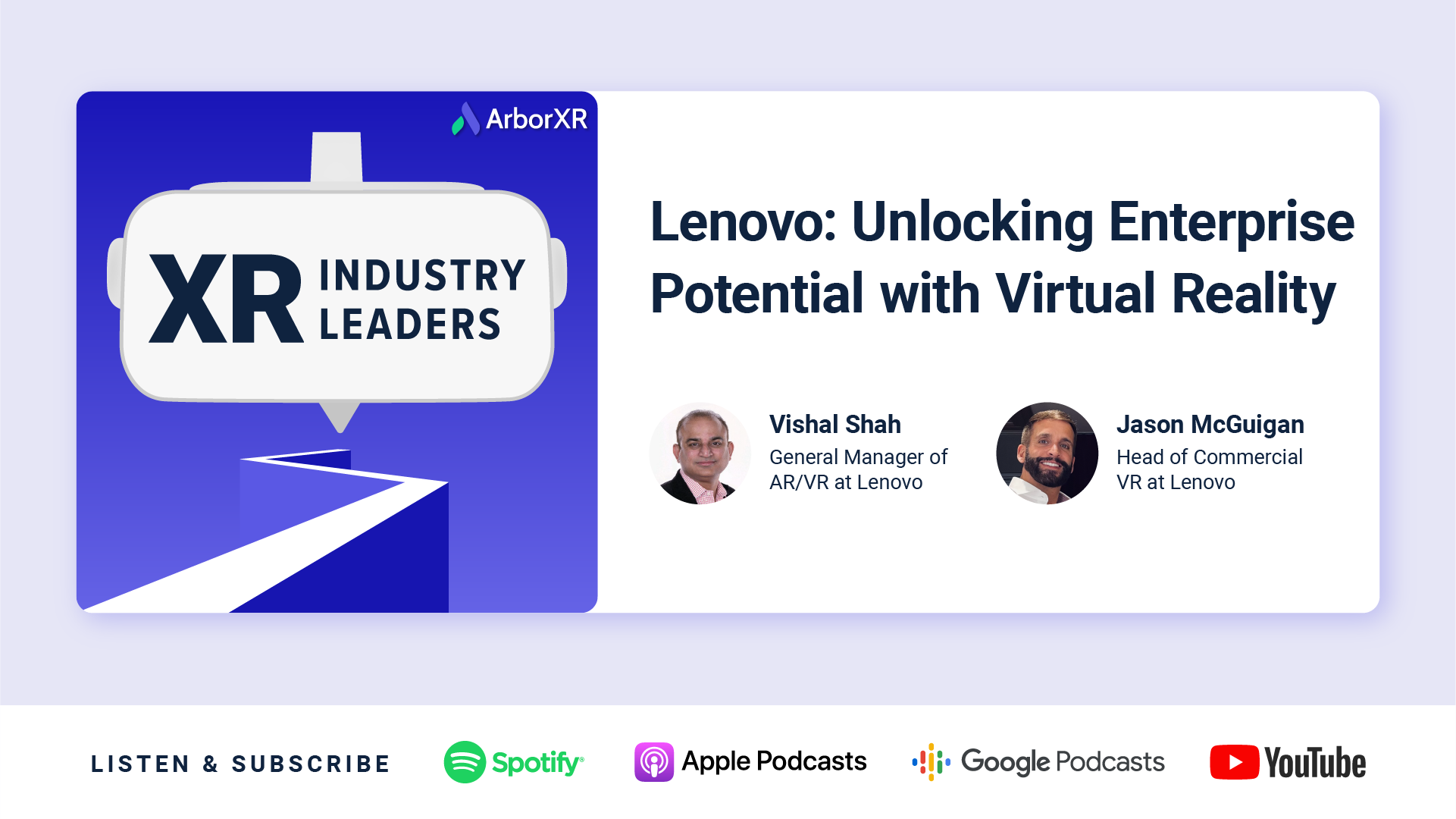
Lenovo: Unlocking Enterprise Potential with VR
Dive into the dynamic world of extended reality (XR) with Lenovo’s Vishal Shah and Jason McGuigan as they unravel Lenovo’s new enterprise XR solution: the Lenovo ThinkReality VRX.

PICO: Practical Enterprise Applications in XR at Scale
Explore XR’s future with PICO’s Amir Khorram in XR Industry Leaders. Insightful discussion on VR enterprise solutions, partnerships, and industry adoption.
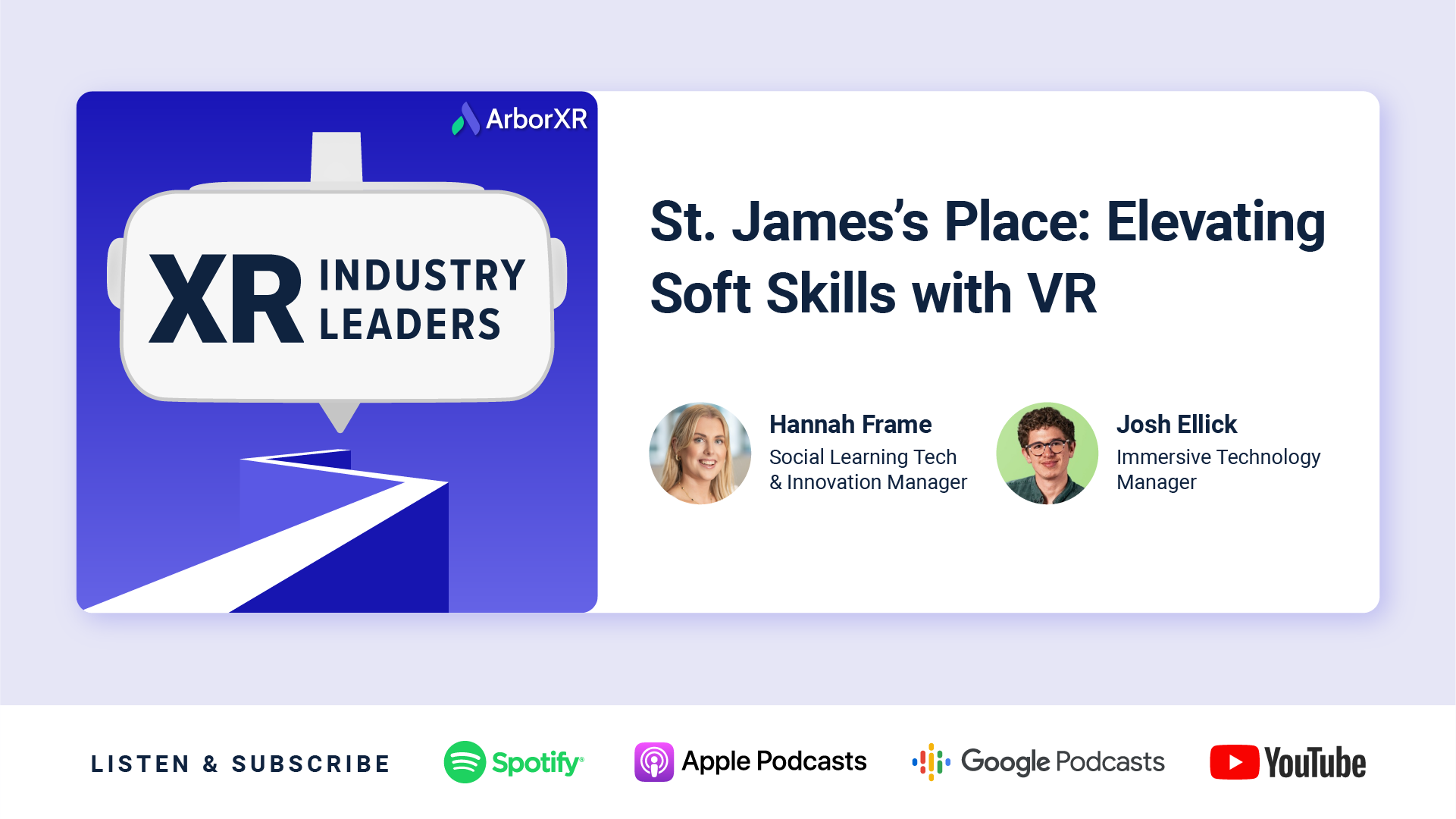
St. James’s Place: Elevating Soft Skills with VR
Hannah & Josh St. James’s Place discuss using VR to train advisor soft skills, challenges of managing headsets at scale, lessons on user adoption, and content development.
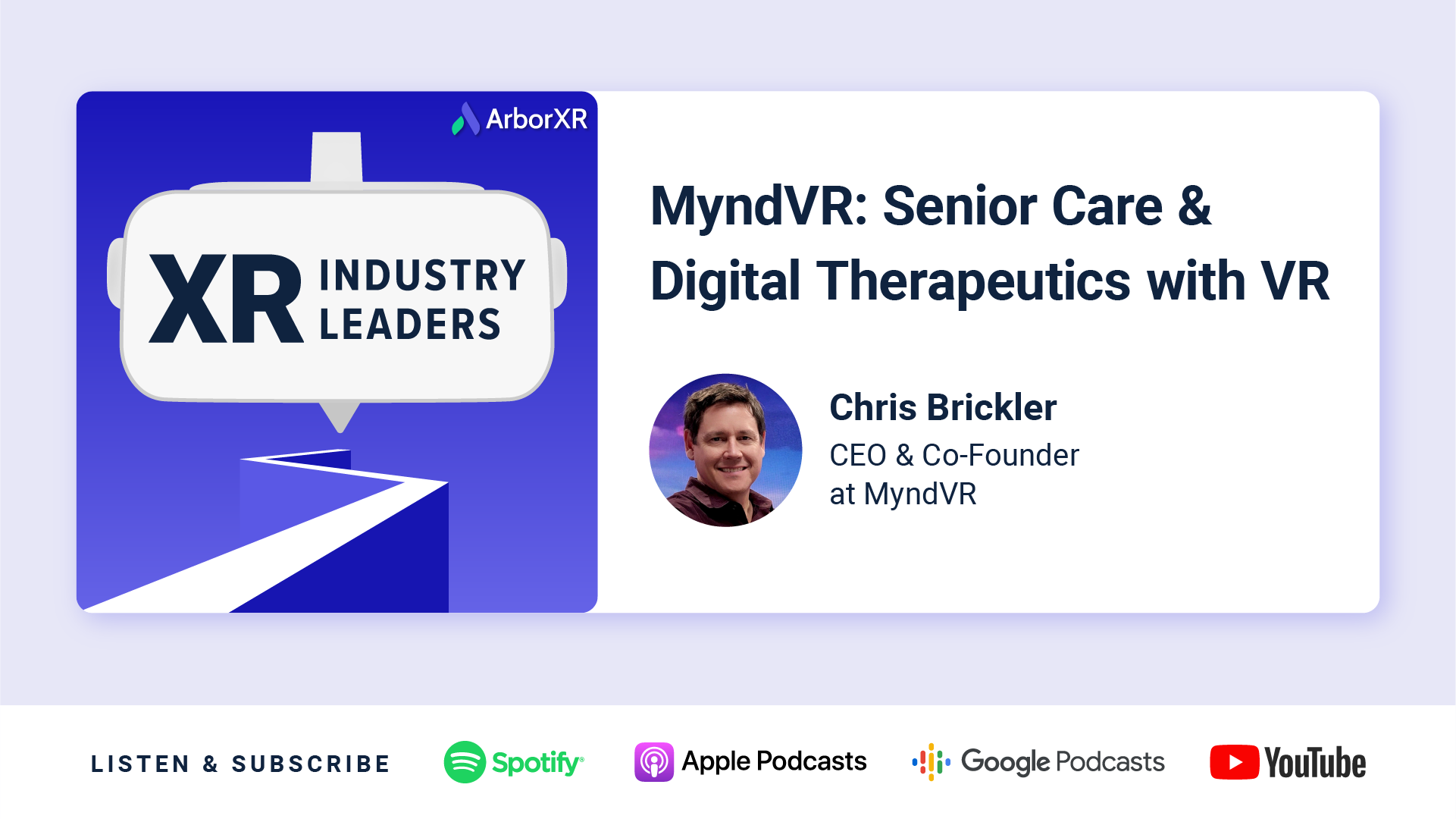
MyndVR: Senior Care and Digital Therapeutics with VR
Chris Brickler shares how VR therapy improves memories and care for elderly patients, and the challenges of scaling VR across health senior care facilities.
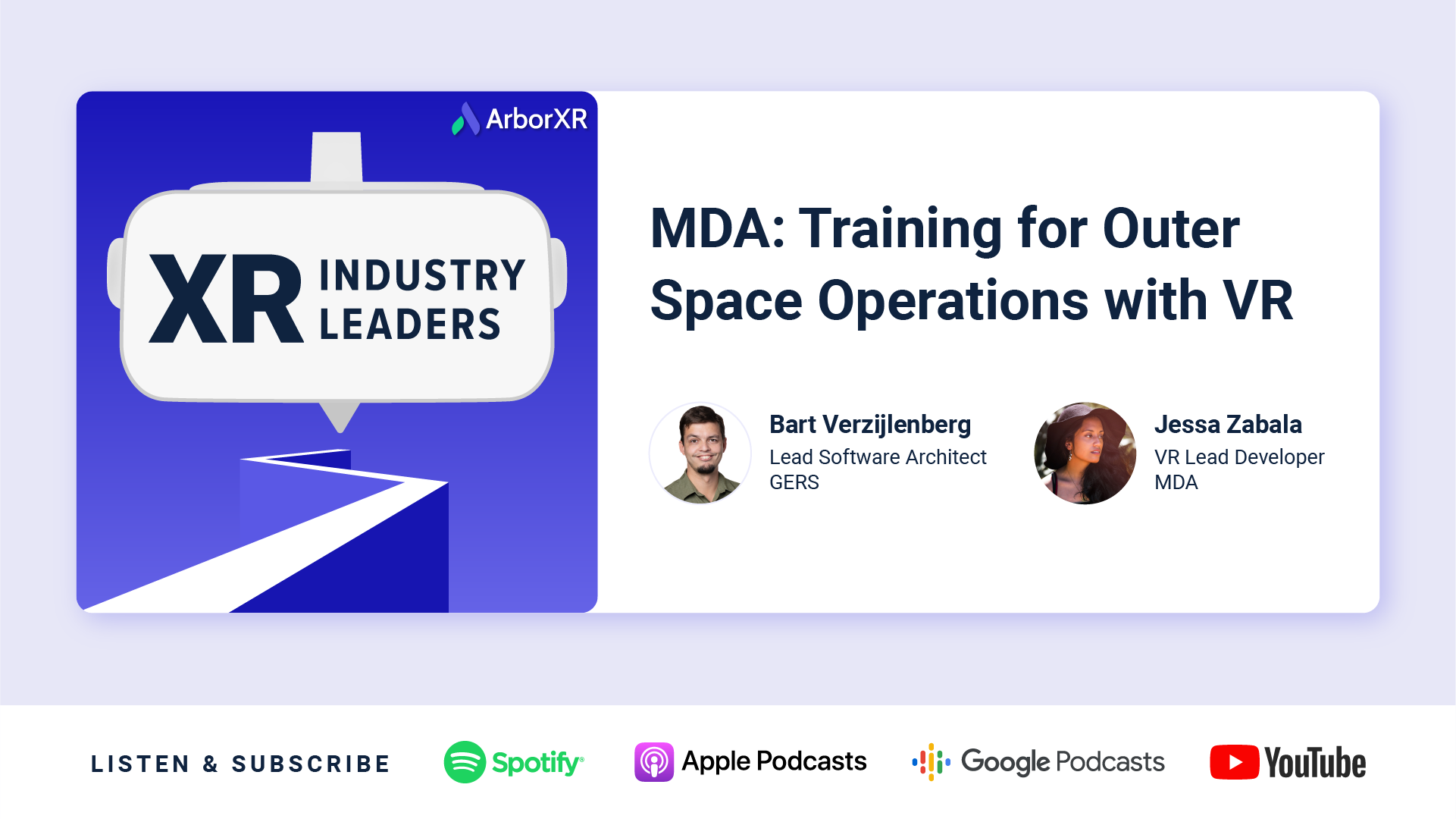
MDA: Training For Outer Space Operations with VR
Discover how MDA leverages VR for astronaut training, mission planning, and onboarding. Gain valuable insights into implementing immersive technologies at scale.

Harvard: Experiential VR Learning in Education
Matt Cook from Harvard joins us to discuss how virtual & augmented reality are redefining higher education through customized immersive experiences.
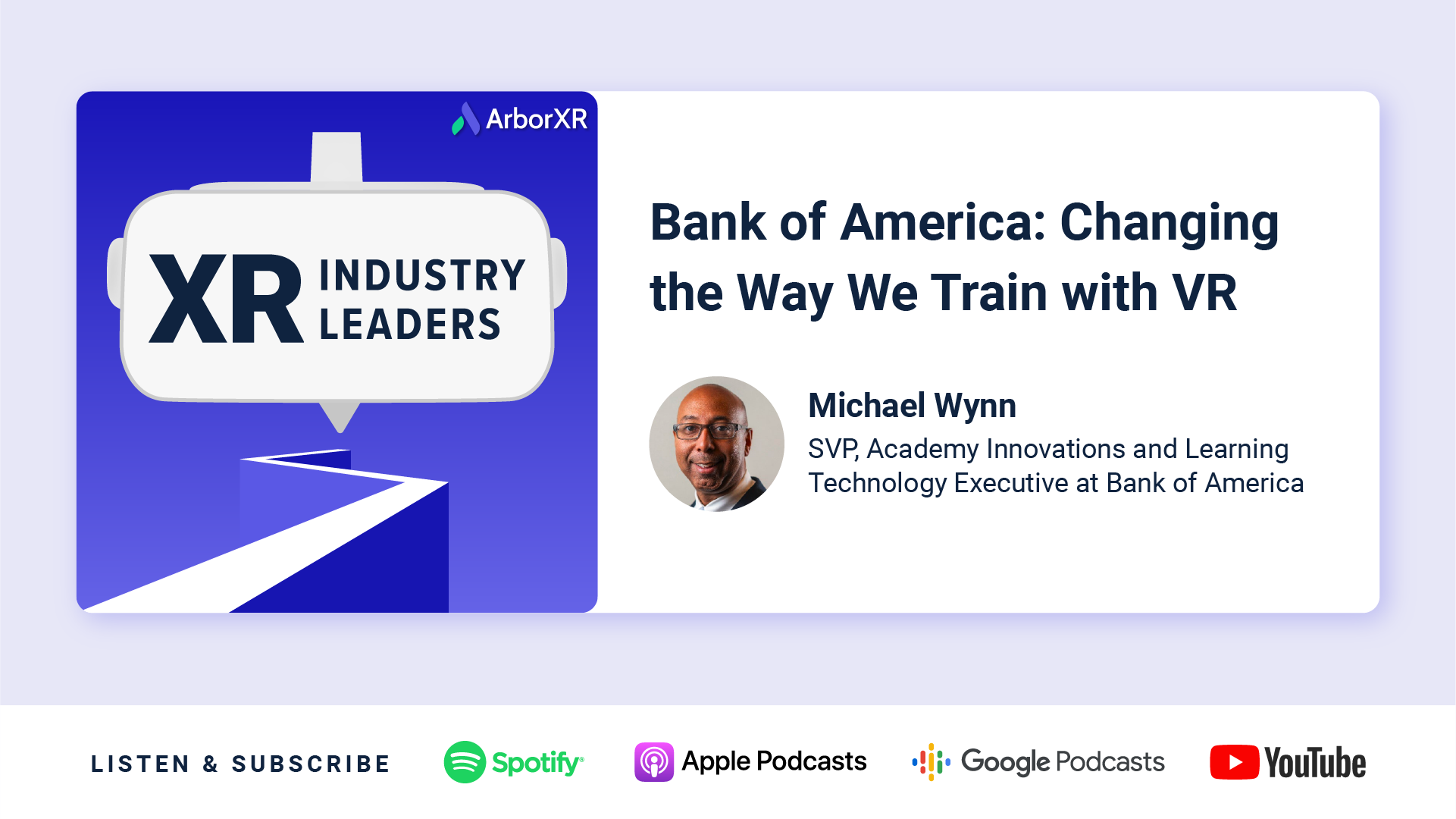
Bank of America: Changing the Way We Train with VR
Explore how Bank of America is revolutionizing training with VR, enhancing employee engagement, overcoming challenges with VR, and redefining corporate education.
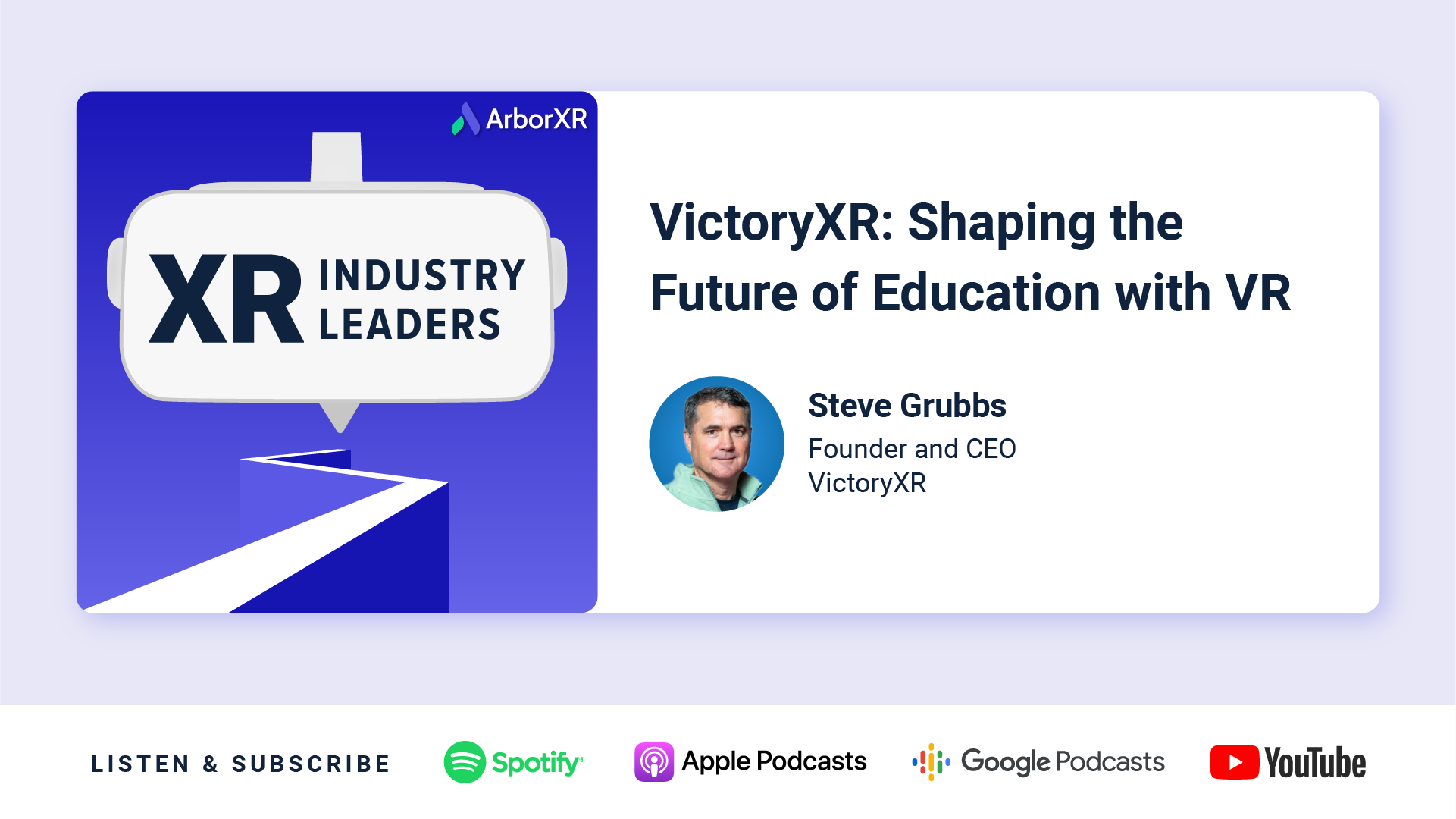
VictoryXR: Shaping the Future of Education with VR
VictoryXR CEO Steve Grubbs discusses creating virtual reality curriculums for education, working closely with Meta, and the future of immersive technology for teachers and students.

VRpatients: Designing Your Own VR Training for Healthcare
Learn how VRpatients creates VR simulations that instructors can customize to give trainees real-life experiences in healthcare.
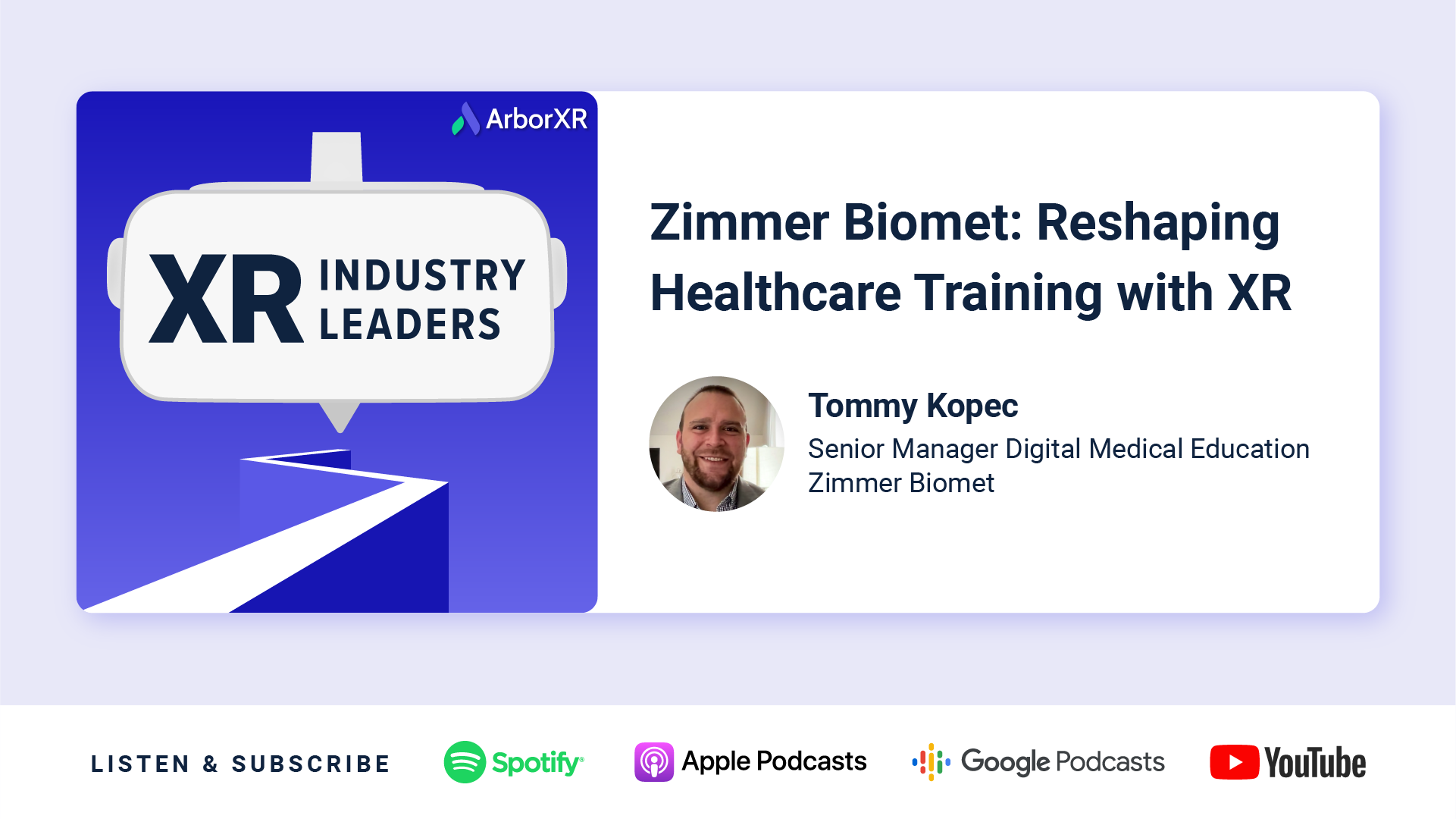
Zimmer Biomet: Reshaping Healthcare Training with AR and VR
If you’re interested in how XR will shape medicine going forward, this is a must-listen episode. Tommy Kopec of Zimmer Biomet provides an insider’s perspective on VR’s transformative potential for surgery, training, and beyond.
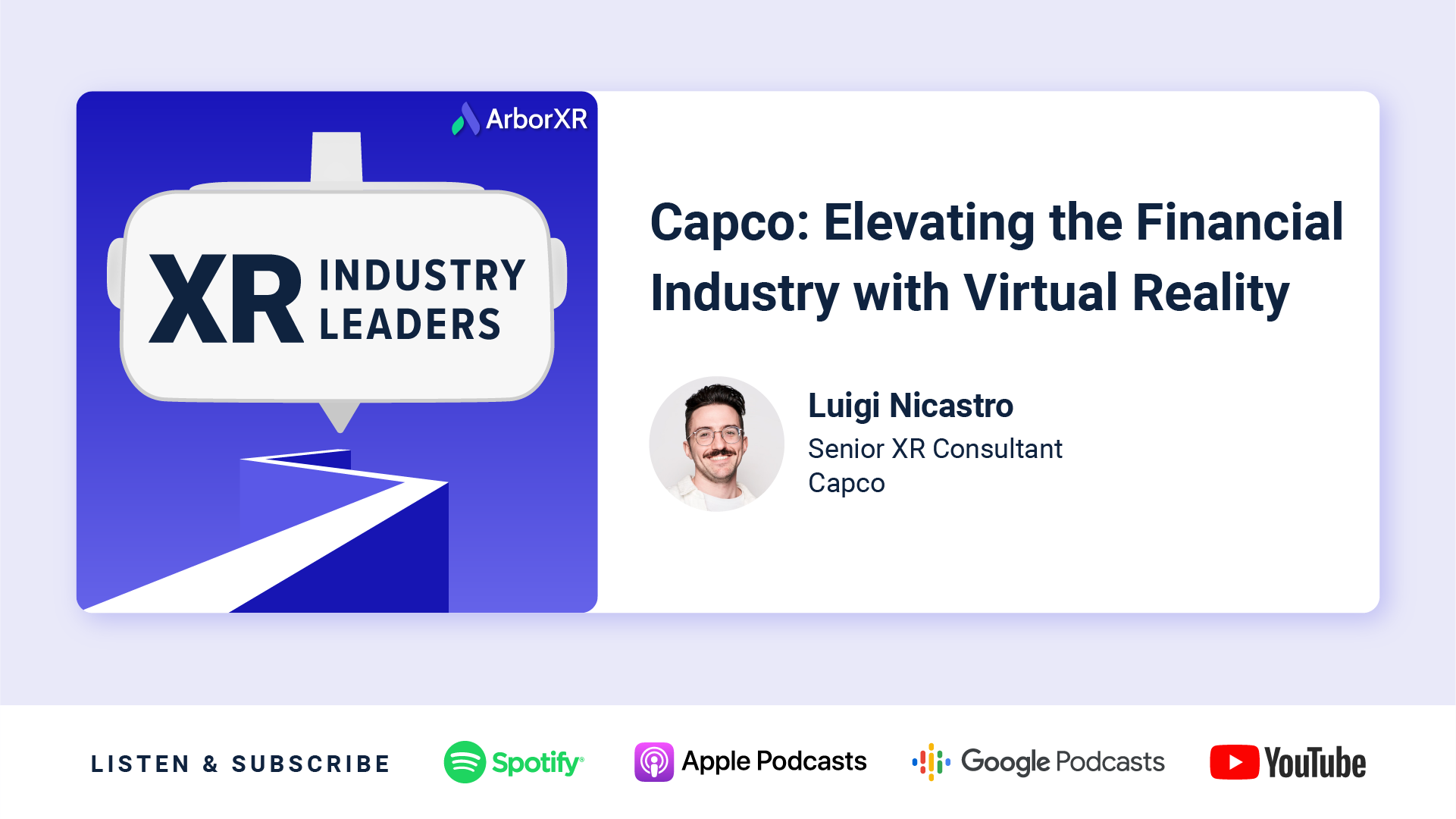
Capco: Elevating the Financial Industry with Virtual Reality
Explore how Capco revolutionizes the financial industry with virtual reality. Discover their success, challenges, and predictions for VR’s impact.

MIT: Exploring Extended Reality in Historic Operas
Discover how MIT uses AR and VR to create immersive experiences for historic operas. We discuss XR in education, challenges and advice for new adopters, and more.

Magic Leap: How Augmented Reality is Elevating Enterprise
Discover how Magic Leap is taking augmented reality to the next level with their enterprise-focused hardware, including real-world statistics and use cases.

Bodyswaps: Innovating Soft Skills Training with Virtual Reality
Discover the future of VR in education with Bodyswaps. Learn how VR elevates soft skills training, and how to implement VR technology effectively.
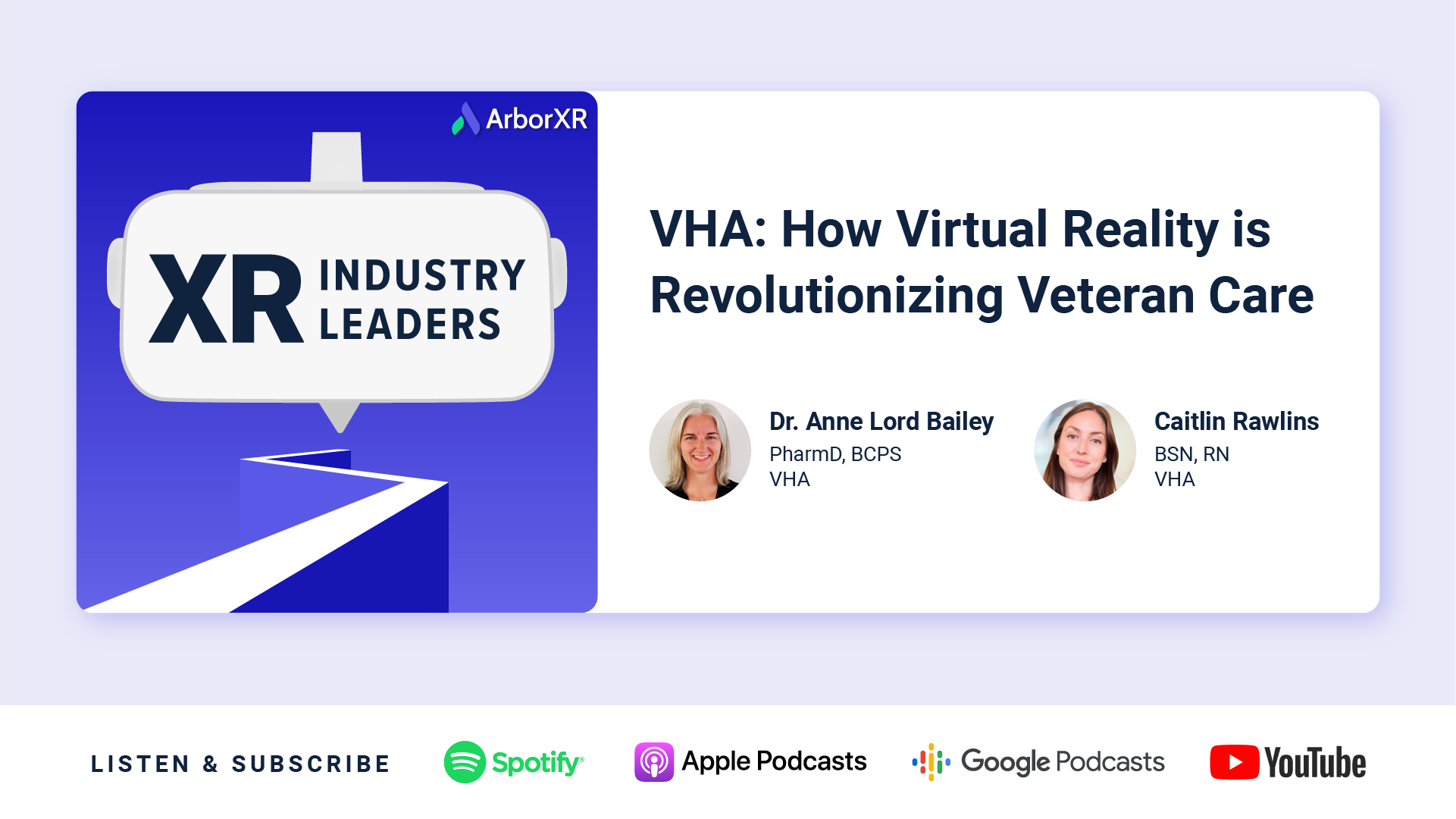
VHA: How Virtual Reality is Revolutionizing Veteran Care
Discover how the VHA is using virtual reality to improve the lives of veterans with pain management, mental health, and overall well-being.
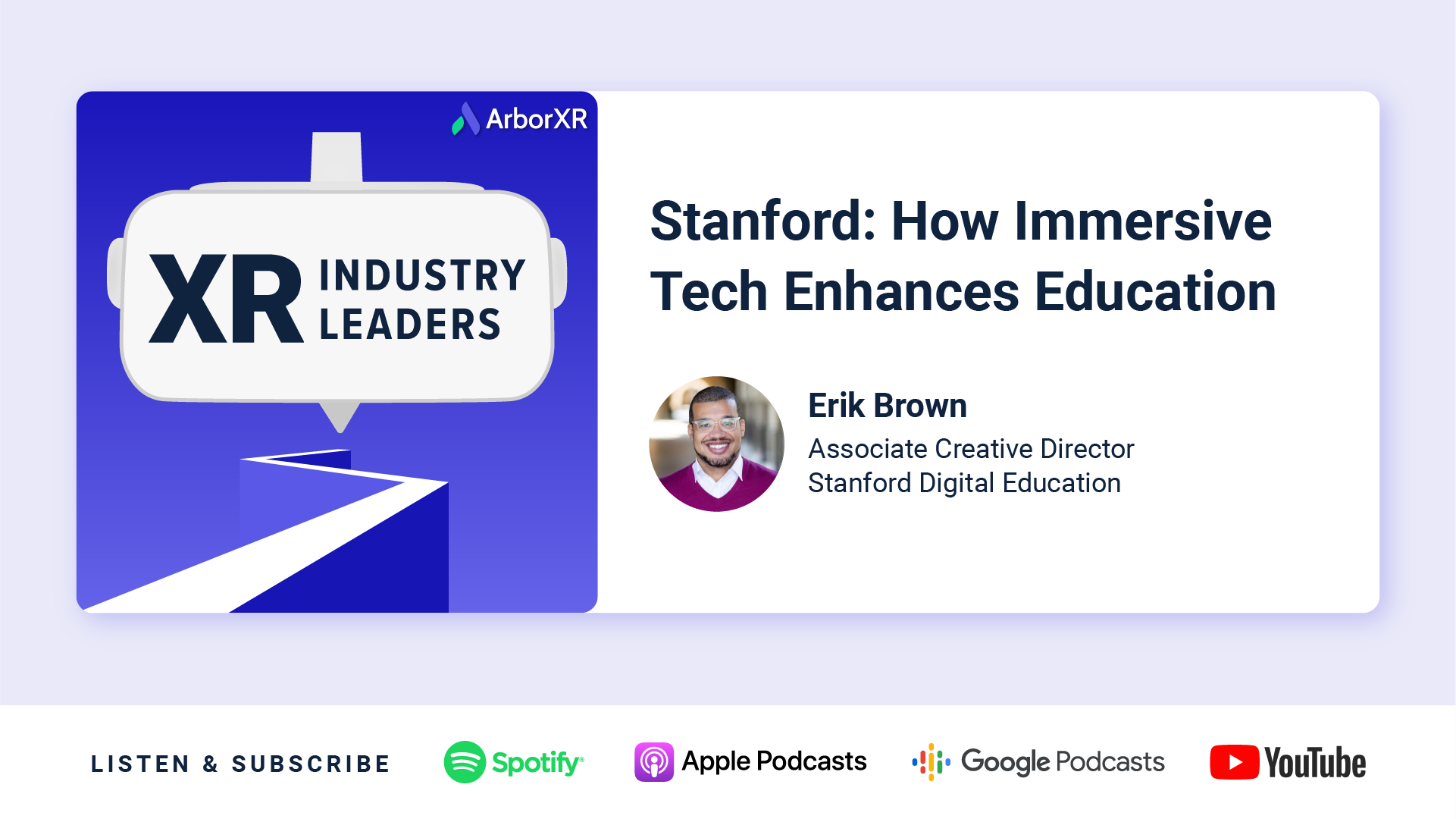
Stanford: How Immersive Technology Enhances Education
Erik Brown discusses how Stanford uses virtual reality for education, empathy in VR, challenges with creating and managing XR content, and more.
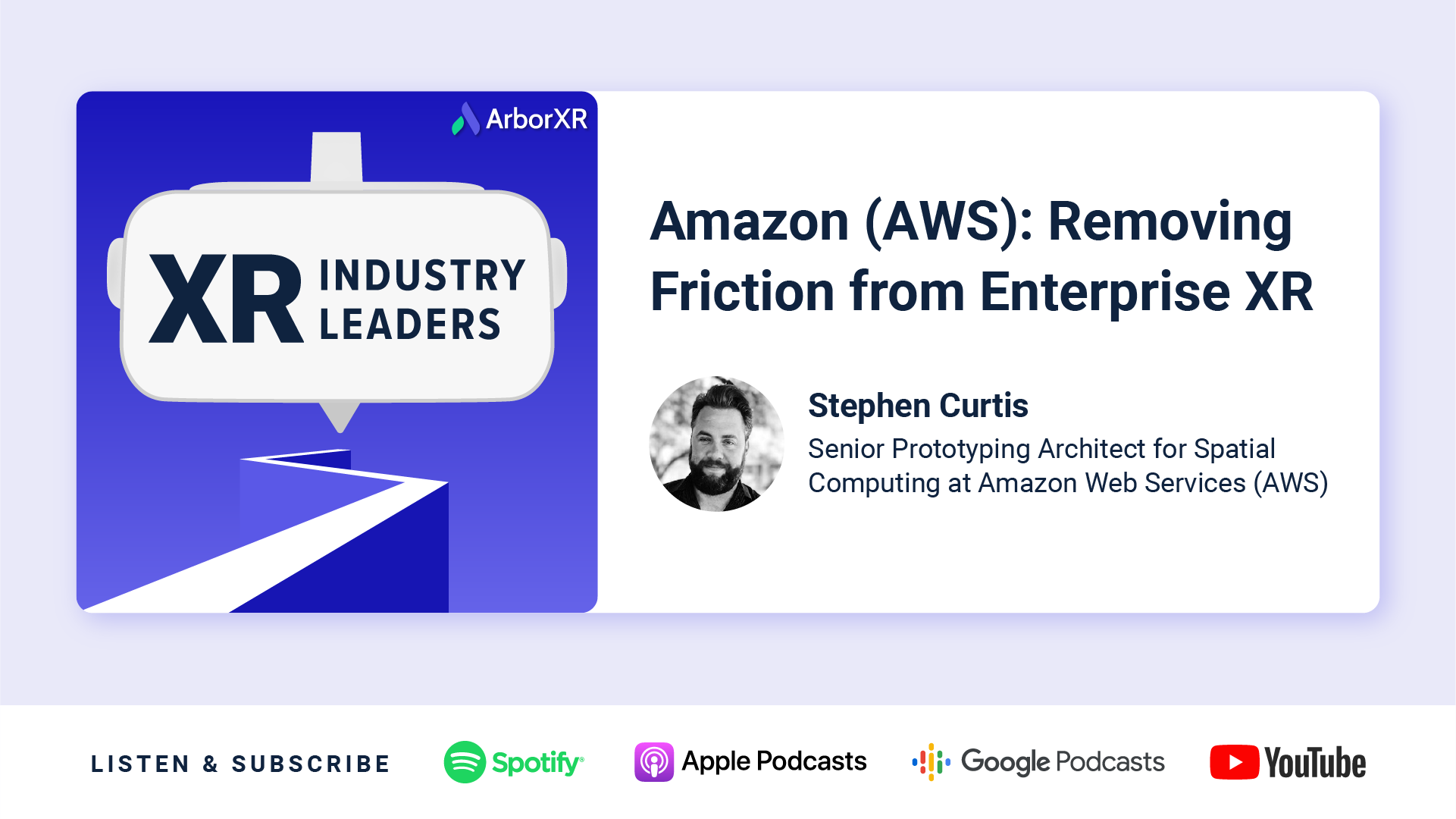
Amazon (AWS): Removing Friction from Enterprise XR
Stephen Curtis from AWS discusses how XR solves enterprise friction, advice for new adopters, XR content authoring, XR device management and more.

WestRock: How XR is Accelerating Manufacturing
XR champion Scott Burkey discusses the impact AR and VR is having on manufacturing, challenges implementing new technology, and advice for using XR in business.

Pfizer: Transforming How We Train with XR
XR leader Nicholas Hockley discusses how XR transformed the way Pfizer trains, challenges with AR/VR content, moving from a pilot program to scale, and more.
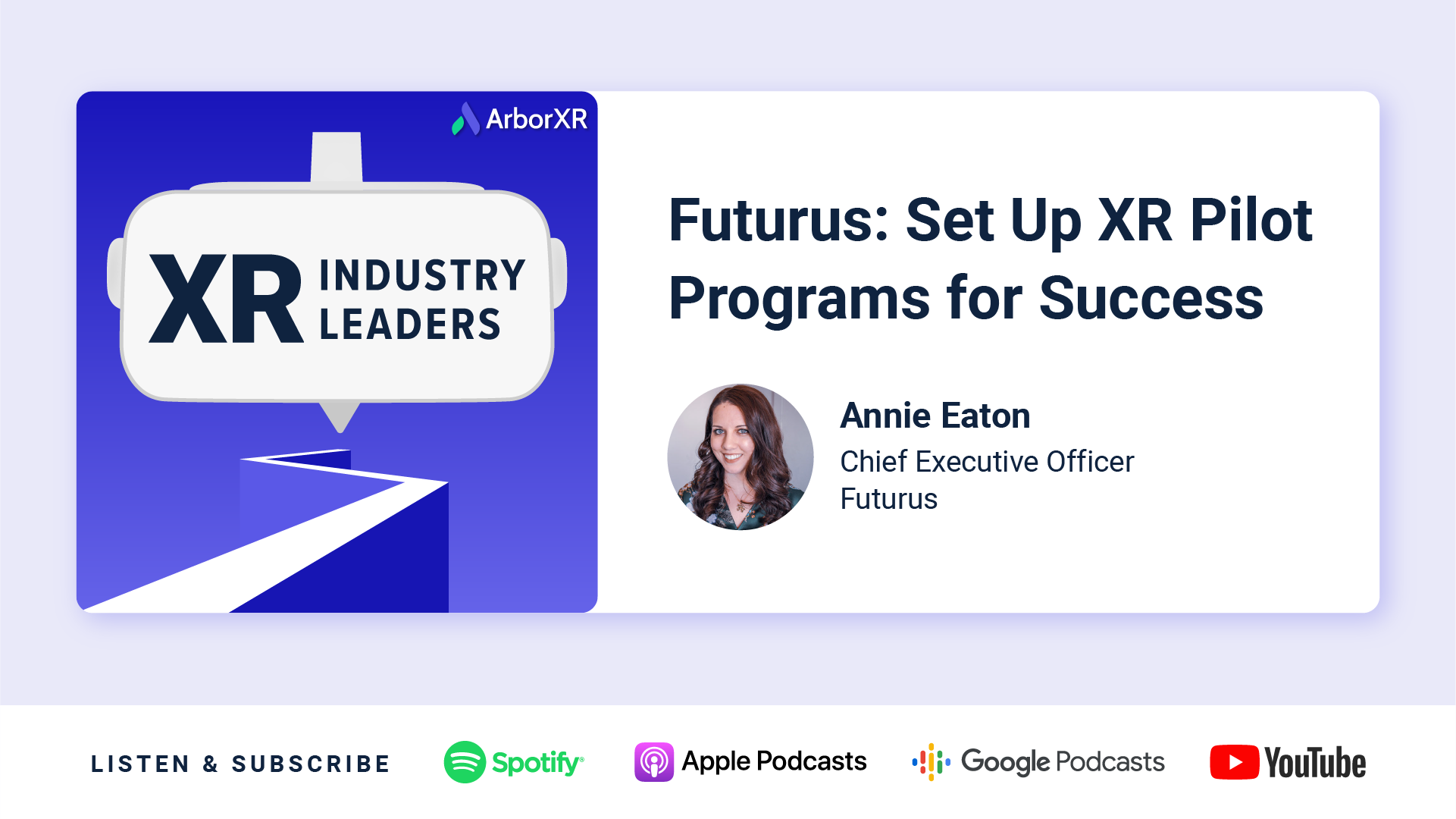
Futurus: Set Up XR Pilot Programs for Success
Futurus CEO Annie Eaton discusses creating AR/VR content, how to set up XR pilot programs for success, challenges in XR, advice for new adopters, and more.
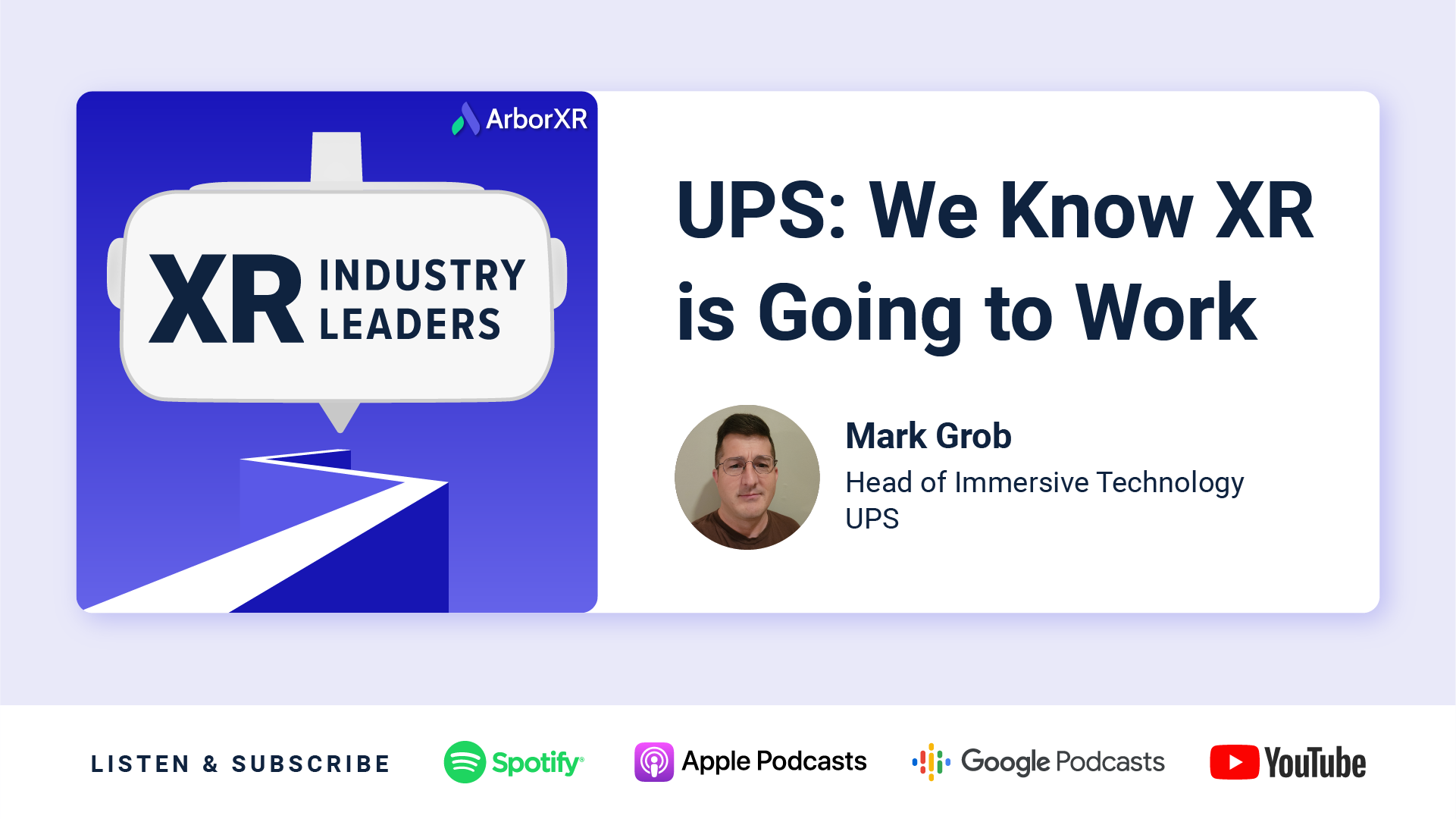
UPS: We Know XR is Going to Work
Learn how UPS built XR training as a practice. We discuss using AR/VR in business, challenges and benefits of XR training, advice for new adopters & more.

INVISTA (Koch Industries): What if We Reimagined Our Entire Training Process?
Learn how XR is transforming INVISTA (Koch). We discuss using AR/VR in business, challenges and benefits of XR training, strategy to scaling XR adoption & more.

Lenovo: Unlocking Enterprise Potential with VR
Dive into the dynamic world of extended reality (XR) with Lenovo’s Vishal Shah and Jason McGuigan as they unravel Lenovo’s new enterprise XR solution: the Lenovo ThinkReality VRX.

PICO: Practical Enterprise Applications in XR at Scale
Explore XR’s future with PICO’s Amir Khorram in XR Industry Leaders. Insightful discussion on VR enterprise solutions, partnerships, and industry adoption.

St. James’s Place: Elevating Soft Skills with VR
Hannah & Josh St. James’s Place discuss using VR to train advisor soft skills, challenges of managing headsets at scale, lessons on user adoption, and content development.

MyndVR: Senior Care and Digital Therapeutics with VR
Chris Brickler shares how VR therapy improves memories and care for elderly patients, and the challenges of scaling VR across health senior care facilities.

MDA: Training For Outer Space Operations with VR
Discover how MDA leverages VR for astronaut training, mission planning, and onboarding. Gain valuable insights into implementing immersive technologies at scale.

Harvard: Experiential VR Learning in Education
Matt Cook from Harvard joins us to discuss how virtual & augmented reality are redefining higher education through customized immersive experiences.

Bank of America: Changing the Way We Train with VR
Explore how Bank of America is revolutionizing training with VR, enhancing employee engagement, overcoming challenges with VR, and redefining corporate education.

VictoryXR: Shaping the Future of Education with VR
VictoryXR CEO Steve Grubbs discusses creating virtual reality curriculums for education, working closely with Meta, and the future of immersive technology for teachers and students.

VRpatients: Designing Your Own VR Training for Healthcare
Learn how VRpatients creates VR simulations that instructors can customize to give trainees real-life experiences in healthcare.

Zimmer Biomet: Reshaping Healthcare Training with AR and VR
If you’re interested in how XR will shape medicine going forward, this is a must-listen episode. Tommy Kopec of Zimmer Biomet provides an insider’s perspective on VR’s transformative potential for surgery, training, and beyond.
